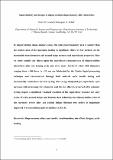Superelasticity and fatigue in oligocrystalline shape memory alloy microwires
Author(s)
Ueland, Stian M.; Schuh, Christopher A.
DownloadSchuh_Superelasticity and.pdf (728.1Kb)
PUBLISHER_CC
Publisher with Creative Commons License
Creative Commons Attribution
Terms of use
Metadata
Show full item recordAbstract
In oligocrystalline shape memory alloys, the total grain boundary area is smaller than the surface area of the specimen, leading to significant effects of free surfaces on the martensitic transformation and related shape memory and superelastic properties. Here we study sample size effects upon the superelastic characteristics of oligocrystalline microwires after one loading cycle and after many. Cu–Zn–Al wires with diameters ranging from ∼100 down to ∼20 μm are fabricated by the Taylor liquid processing technique and characterized through both uniaxial cyclic tensile testing and mechanically constrained thermal cycling. The energy dissipated per superelastic cycle increases with decreasing wire diameter, and this size effect is preserved after extensive cycling despite a significant transient evolution of the superelastic response for early cycles. We also present fatigue and fracture data, indicating that oligocrystalline wires of this normally brittle alloy can exhibit fatigue lifetimes two orders of magnitude improved over conventional polycrystalline Cu–Zn–Al.
Date issued
2011-10Department
Massachusetts Institute of Technology. Department of Materials Science and EngineeringJournal
Acta Materialia
Publisher
Elsevier
Citation
Ueland, Stian M., and Christopher A. Schuh. “Superelasticity and Fatigue in Oligocrystalline Shape Memory Alloy Microwires.” Acta Materialia 60, no. 1 (January 2012): 282–292.
Version: Author's final manuscript
ISSN
13596454
1873-2453